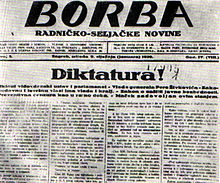Borba(newspaper)
 Front page of the 9 January 1929 issue | |
| Type | Weekly (1922–1929); (1942–1943) Three-times a week (1941) Dailynewspaper(1944–2009) Monthly (2020–) |
|---|---|
| Format | Berliner |
| Founded | 19 February 1922 |
| Political alignment | Communist Party of Yugoslavia |
| Headquarters | Zagreb(1922–1929) Užice(1941) Drinić(1942–1943) Priluka(1943) Belgrade(1944–2009, 2020–) |
| ISSN | 0350-7440 |
| OCLCnumber | 12303752 |
| Website | borba |
Borba(Serbo-Croatian Cyrillic:Борба) was a newspaper published informer YugoslaviaandSerbia,best known from the period when it was the official gazette of theLeague of Communists of Yugoslavia(LCY) until 1954 andSocialist Alliance of Working People of Yugoslaviathereon until its dissolution. Its name is theSerbo-Croatianword for 'struggle' or 'combat'.[1]
History[edit]
Beginnings and censorship[edit]
The very first issue ofBorbawas first published inZagrebon 19 February 1922,Đuro Cvijić,together withKamil Horvatinbecame the editors of the newspaper at its founding.[2]As the official gazette of theLeague of Communists of Yugoslavia(LCY),[1]a banned political organization since December 1920 that nevertheless operated clandestinely in theKingdom of Serbs, Croats and Slovenesand later Kingdom of Yugoslavia. From 1924, the editor of Borba wasVladimir Ćopić,who was soon arrested for his articles against the government. Functioning as the banned Yugoslav Communist Party's propaganda piece, the paper played in important part in disseminating information among the party members, activists, and sympathizers.
On 13 January 1929, a week following the proclamation ofKing Alexander's6 January Dictatorship,Borbagot banned.
World War 2[edit]
DuringWorld War IIBorbawas published in theRepublic of Užice.After theWorld War IIliberation by thePartisans,its publication moved toBelgrade.
Post-war period[edit]

From 1948 to 1987, the newspaper was also published simultaneously inZagreb.For a long time,Borbaalternated pages inSerbian Cyrillic alphabetandGaj's Latin alphabetin the same edition.
Changes in editorial policy, Yugoslav Wars and ownership changes[edit]
In July 1986,Stanislav Staša Marinkovićbecame the editor-in-chief ofBorba,and soon afterwards, he started rebranding the anachronistic Communist government newspaper into one of the most liberal daily newspapers in Yugoslavia. After Marinković's death in 1989, Manojlo Vukotić kept the same policy, so in the beginning of theYugoslav Wars,Borbajournalists took an anti-war stance, and in 1992 and 1993Borbabecame one of the most important strongholds of the opponents toSlobodan Miloševićwar policies. In 1993, after an internal conflict, Vukotić is replaced bySlavko Ćuruvija,and in 1994, government took overBorbaovernight, changing the editorial staff, and 120Borbaemployees left the magazine, which, after that, became the proponent of Milošević's regime under the new editorDragutin Brčin.Yet the core ofBorbajournalists continued publishing different anti-Milošević publications - soon after the 1994 government takeover, a group of formerBorbajournalists started publishingNaša borba.In 1997, most of theNaša borbajournalists establishedDanas,which is still published today. In 1996, formerBorbaeditor Manojlo Vukotić startedBlic,which is also still published today, and in the same year Slavko Ćuruvija started publishingDnevni telegraf,which was published until Ćuruvija's assassination in March 1999.
Meanwhile,Borba's reputation rapidly deteriorated under Brčin, and the newspaper lost almost entire readership in a few years. After the2000 overthrow of Slobodan Milošević,Borba had to face complete transformation. In 2002,Borbaalong with its distribution network were purchased by Serbian businessmanStanko "Cane" Subotićwho bought the government shares in the paper. However, under Subotić, the dailyBorbabarely survived, printing no more than several hundred copies a day while according to business records, the company's monthly revenues never exceeded €30,000.[3]
2009 redesign and cease of publication[edit]
RedesignedBorbagot announced in December 2008 withIvan Radovanovićpresented as the paper's new owner after reportedly buying it from fugitive Serbian businessmanStanko "Cane" Subotić.[4]Before the first issue of the redesigned paper appeared, Serbian deputy prime ministerMlađan Dinkićaccused Subotić of still beingBorba's true owner with Radovanović only serving as the front man.[5]
Though announced for December, the first redesigned issue ended up appearing on newsstands on 15 January 2009 undereditor-in-chiefMiloš Jevtović who came over from the state-ownedTanjugnews agency. It was published by "Izdavačko preduzeće Novine Borba" using the Latin alphabet. Content-wise, the paper's new format was conceived as something new on the Serbian print media market with no news wire items and press releases with only analysis of the current events as well as ongoing political and social trends. Initial editor-in-chief Jevtović was soon replaced with Olivera Zekić.[6]However, the paper sold poorly (less than 3,000 copies per day), ceasing publication in October 2009 after less than a year.
2020 reestablishment[edit]
In 2020,Borbastarted publishing once again, as a monthly magazine dedicated to culture, art and promoting traditional and conservative values. Although the magazine had government support and in 2021 celebrated its 99th anniversary, the former journalists and editors ofBorbastrongly criticized this publication.Radomir Ličina,who was aBorbajournalist and editor from 1969 to 1994, said he felt "nothing but disgust at the attempts to ruthlessly appropriate something that belonged only to people who for decades devotedly defended and advocated clear and recognizable journalistic principles and lasting and unchanging civic and human values even in the most difficult of times".[7]
In February 2022, both newly formedBorbamagazine and several different groups of former Borba journalists organized gatherings commemorating 100th anniversary of the first issue ofBorba.
References[edit]
- ^abPål Kolstø (28 December 2012).Media Discourse and the Yugoslav Conflicts: Representations of Self and Other.Ashgate Publishing, Ltd. p. 259.ISBN978-1-4094-9164-4.Retrieved21 November2014.
- ^Vesović, Milan (1979).Revolutionary Press in the Kingdom of Serbs, Croats and Slovenes.Belgrade. p. 108.
{{cite book}}:CS1 maint: location missing publisher (link) - ^Investigation: Mystery Hangs Over Death of Yugoslavia’s Flagship Paper;BalkanInsight, 13 April 2011
- ^Predstavljene nove dnevne novine - "Borba";mondo.rs, 2 December 2008
- ^Ponovo izlazi Borba;B92, 2 December 2008
- ^Impressum
- ^"Huber: Svako ko tvrdi da je baštinik bivše Borbe, samo krivotvori istoriju".danas.rs.20 February 2021.Retrieved23 May2022.
- Newspapers of the world, XXII: "Borba",in:The Times,22 April 1965, page 11
Further reading[edit]
- Merrill, John C. and Harold A. Fisher.The world's great dailies: profiles of fifty newspapers(1980) pp 89–95

